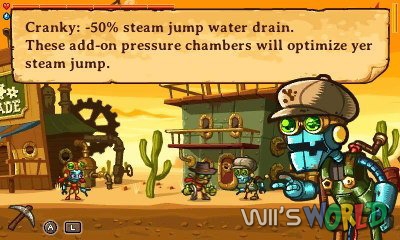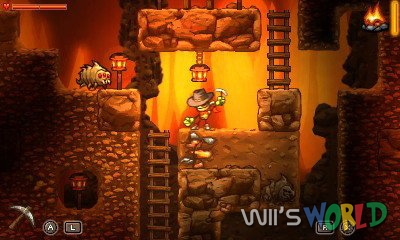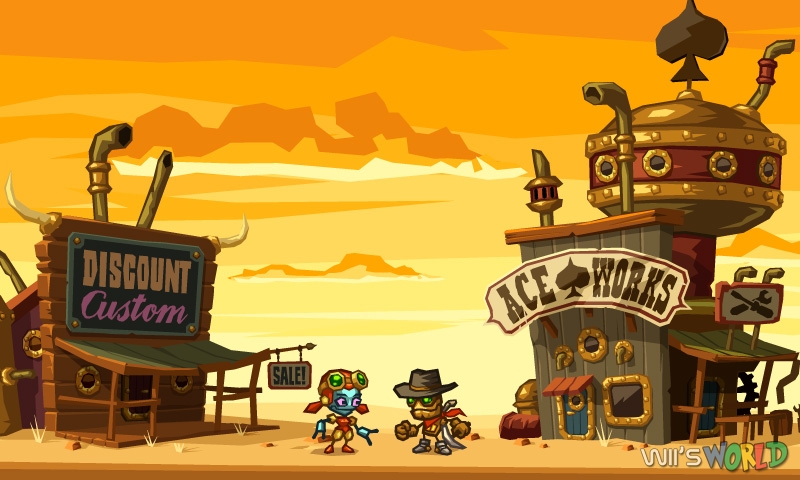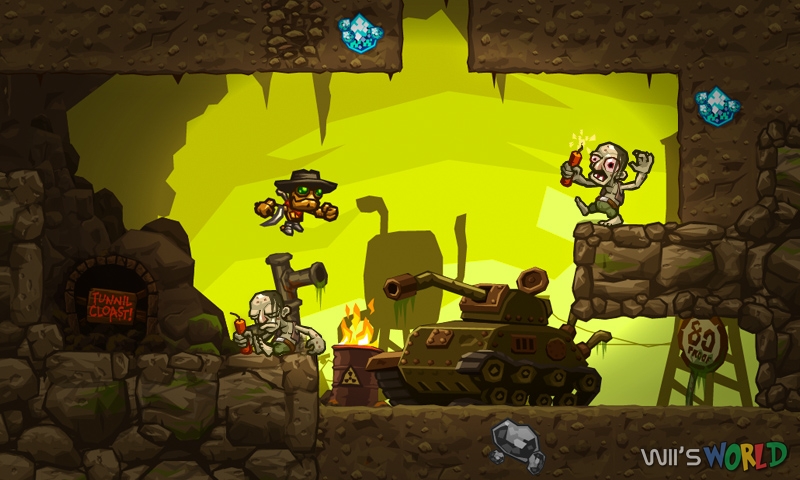
Published by Image & Form, Developed by Image & Form
Genres: Platformer (1 players)
US release date: Aug 8th, 2013 | EU release date: Aug 7th, 2013
Prices: $8.99 (US) | £7.99 (UK) | €8.88 (EUR)
Your mission: Review Steamworld Dig without mentioning Minecraft.
SteamWorld Dig is a follow-up to Image & Form's SteamWorld: Tower Defense, which arrived on DSiWare back in the summer of 2010. Although it takes place in the same world as its predecessor, SteamWorld Dig controls like a platform game, the objective is mining, and the emergent gameplay makes it an adventure.
The game continues to expand on the universe created in predecessor, and tells the story of an alternate-history in which humans are the thieving, dynamite-wielding bad guys from whom the robots need to defend their mines. The alluded to, but largely untold, background story runs as follows: Humanity made great forward strides in technology at the turn of the 20th century and created steam-driven robots to replace the working class. Soon enough, however, humankind entered into a great war and was all but destroyed, with the remaining desperate low-lives lingering underground. There they now lurk, drinking or sleeping until disturbed by the protagonist Rusty, an industrious young heir to a jewel mine.
 Rusty the "cowbot" swaggers into a town called Tumbleton clutching the deeds bequeathed to him by his long-since disappeared uncle. The inhabitants frequently talk about Uncle Joe's mysterious exploits, and imply that something is slightly amiss with the town. It's down to Rusty to discover what that is.
Rusty the "cowbot" swaggers into a town called Tumbleton clutching the deeds bequeathed to him by his long-since disappeared uncle. The inhabitants frequently talk about Uncle Joe's mysterious exploits, and imply that something is slightly amiss with the town. It's down to Rusty to discover what that is.
The core gameplay consists of using a pick to destroy square blocks representing soil. While the beginning of the game can be slow going, it eventually becomes compelling and even strategic. The central idea is to mine your way to precious metals and jewels, while bearing in mind five things:
 Dying in the mines requires you to be rebuilt and costs you half of your cash, although your dropped stash of precious stones can be retrieved from wherever your body fell. Along the way, you'll also find puzzle rooms which can be restarted at no cost when you die. These often include puzzle-like elements and, when completed, yield new upgrades which can be purchased in town.
Dying in the mines requires you to be rebuilt and costs you half of your cash, although your dropped stash of precious stones can be retrieved from wherever your body fell. Along the way, you'll also find puzzle rooms which can be restarted at no cost when you die. These often include puzzle-like elements and, when completed, yield new upgrades which can be purchased in town.
Once you've collected a few gems - or your lamp begins to run down - you can return to town to sell them for cash. The surface represents a hub of sorts, that feels not unlike an Animal Crossing village in two dimensions. The town starts off small, with just one shop selling upgrades, such as more powerful pickaxes. As your mine prospers, two more will be built, which will sell armor, water storage upgrades, power-ups for your hydraulic fist, larger pouches to hold gems and other goodies.
Among the resources you'll have to manage is light, which requires you to make regular trips to the surface or to buy oil lamps with which to illuminate your way. You'll also need water, which can be replenished in underground pools and is sometimes relinquished by enemies you take out. Similarly, health can be dropped by vanquished foes or bought in the village store.
 The enemies early on in the game take the shape of bugs and other subterranean critters, but soon become far more menacing and eventually high-tech the deeper you dig. Whatever happened to Rusty's uncle? Why does the technology seem to become increasingly advanced as you descend? Are the sentry guns being controlled by some kind of sentient foe? These are some of the mysteries that will spur you on to greater depths as you play.
The enemies early on in the game take the shape of bugs and other subterranean critters, but soon become far more menacing and eventually high-tech the deeper you dig. Whatever happened to Rusty's uncle? Why does the technology seem to become increasingly advanced as you descend? Are the sentry guns being controlled by some kind of sentient foe? These are some of the mysteries that will spur you on to greater depths as you play.
As well as the cash you make in exchange for gems, you'll also be spending mysterious blue orbs which are found underground. These can be used to buy transporters, which relieve the grunt work of wall-jumping back up the deep mine shaft you just dug. However, there are a finite number of orbs to be found, so the convenience of transporters must be weighed against the benefits of the other power-ups the orbs can buy you, such as more powerful drills.
The game's main underground area maps are generated dynamically, which means that no two game sessions will be the same. The locations of objects, exits, shortcuts, treasure, etc, are randomized within certain parameters, so the game can be replayed in order to be fully explored. As resources are finite, it is also worth replaying SteamWorld Dig to simply try different upgrade tactics and digging strategies.
 Background parallax layers are revealed as you dig, and the stereoscopic effect adds a beautiful sense of depth to your mining experience. However, the 3D is of no importance to the gameplay itself. SteamWorld Dig is from the school of games whose central gameplay relies on the D-pad and whose appeal is in discovering ever more efficient ways to carry out an initially "grindy" task: that of digging. What makes the gameplay in SteamWorld Dig feel satisfying is that each square block of soil you smash with your pick is another step towards the discovery of new substrata of lost society or a new technological upgrade.
Background parallax layers are revealed as you dig, and the stereoscopic effect adds a beautiful sense of depth to your mining experience. However, the 3D is of no importance to the gameplay itself. SteamWorld Dig is from the school of games whose central gameplay relies on the D-pad and whose appeal is in discovering ever more efficient ways to carry out an initially "grindy" task: that of digging. What makes the gameplay in SteamWorld Dig feel satisfying is that each square block of soil you smash with your pick is another step towards the discovery of new substrata of lost society or a new technological upgrade.
What starts off as simple pick-swinging eventually becomes a far more exhilarating mix of flipping on your drill arm to break through rocks blocking your path, shooting out a hydraulic punch to tackle enemies from a safe distance or of using your super jump to scale previously inaccessible areas (at this point in a review it is customary to use the phrase "Metroidvania").
What you end up with is a labyrinthine system of tunnels of your own creation; no two players' mines will be exactly alike. Bizarrely, it is actually possible to trap yourself in the unlikely event that you get too drill-happy and forget to pack enough ladders, leaving you with only one option: to self-destruct. Although it's easy to max out your cash levels before the final boss battle, the amount of ore in the game is not infinite, so, theoretically, repeated carelessness could leave you lamenting upgrades that remain out of your reach.
 SteamWorld Dig isn't without its potential problems, however. The first hour of the game might leave you wondering what all the reviewers are raving about: several swings of your weak, starter pickaxe are required to break through the soil, which makes progress ominously laborious. However, if you can persevere through the early stages, Rusty's later upgrades and abilities make progress much more enjoyable.
SteamWorld Dig isn't without its potential problems, however. The first hour of the game might leave you wondering what all the reviewers are raving about: several swings of your weak, starter pickaxe are required to break through the soil, which makes progress ominously laborious. However, if you can persevere through the early stages, Rusty's later upgrades and abilities make progress much more enjoyable.
Another potential turn off for players who fail to get their teleporter strategy right is the need to return to the surface. Uncle Joe left scant few teleporters in his wake, meaning you'll be forced to backtrack a significant stretch if you fail regularly to purchase your own.
Canceling out these shortcomings, however, is the allure of the unknown: the call to adventure as a long-lost subterranean civilization is excavated one layer at a time. Every few hundred meters brings with it new abilities, new revelations and new dangers. At a price of just £6.39 on Nintendo's eShop until Oct 20th for 6-9 hours' worth of top-class entertainment, SteamWorld Dig comes highly recommended.
Gameplay: 
Graphics: 
Sound: 
Lifespan: 
 Japanese Rail Sim 3D Travel of Steam
Japanese Rail Sim 3D Travel of Steam
Sonic Powered
Released on December 7th, 2017
 I am an Air Traffic Controller Airport Hero Narita
I am an Air Traffic Controller Airport Hero Narita
Sonic Powered
Released on June 15th, 2017
 I am an Air Traffic Controller Airport Hero Osaka-KIX
I am an Air Traffic Controller Airport Hero Osaka-KIX
Sonic Powered
Released on June 15th, 2017
 Mysterious Stars 3D: A Fairy Tale
Mysterious Stars 3D: A Fairy Tale
Collavier
Released on May 18th, 2017
 Elliot Quest
Elliot Quest
PlayEveryWare
Released on May 11th, 2017
tonysburger said:
you could probably learn how to make a waffle maker in there ...
T3Knyne said:
Ts university tuff ...
spleefian said:
acting like this is even active at all but i just really dislike it sideways because to me it just looks incomplete ...
spleefian said:
seeing literally just "1 decade ago" is scary to me like id be used to it saying you know 12 or 13 years ago but just ...
spleefian said:
i wish i couldve been here during this sites heyday ...
Wii's World is not officially affiliated with Nintendo! (but they wish we were).
User comments
No posts yet for this game. How about being the first?